|
|
|
Sort Order |
|
|
|
Items / Page
|
|
|
|
|
|
|
| Srl | Item |
| 1 |
ID:
144703
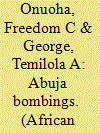

|
|
|
|
|
| Summary/Abstract |
Since his inauguration on 29 May 2015, President Muhammadu Buhari has taken several practical, policy and diplomatic actions aimed at defeating the six-year long insurgency by Boko Haram terrorists in Nigeria. These actions have started to have a modest positive impact on reclaiming the territories previously held by the terrorists. Boko Haram has reacted by ramping up its attacks on soft targets and communities in the north-east. This article focuses on Boko Haram's bombing activities in Nigeria's capital city, Abuja. It shows that between 2011 and 2015, Boko Haram has staged nine bombings in Abuja, resulting in the deaths of at least 191 people, including suicide bombers. It argues that the October 2015 suicide bombings in Kuje and Nyanya, Abuja, represent Boko Haram's bold attempt to respond to President Buhari's counter-insurgency efforts. The article proposes the ‘five Ds’ approach as part of robust measures for combating the insurgency.
|
|
|
|
|
|
|
|
|
|
|
|
|
|
|
|
| 2 |
ID:
129145
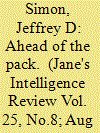

|
|
|
| 3 |
ID:
151190
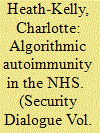

|
|
|
|
|
| Summary/Abstract |
This article explores the extension of counter-radicalisation practice into the National Health Service (NHS). In the 2011 reformulation of the UK Prevent strategy, the NHS became a key sector for the identification and suppression of ‘radicalisation’. Optometrists, dentists, doctors and nurses have been incorporated into counter-terrorism and trained to report signs of radicalisation in patients and staff. This article explores how calculative modalities associated with big data and digital analytics have been translated into the non-digital realm. The surveillance of the whole of the population through the NHS indicates a dramatic policy shift away from linear profiling of those ‘suspect communities’ previously considered vulnerable to radicalisation. Fixed indicators of radicalisation and risk profiles no longer reduce the sample size for surveillance by distinguishing between risky and non-risky bodies. Instead, the UK government chose the NHS as a pre-eminent site for counter-terrorism because of the large amount of contact it has with the public. The UK government is developing a novel counter-terrorism policy in the NHS around large-N surveillance and inductive calculation, which demonstrates a translation of algorithmic modalities and calculative regimes. This article argues that this translation produces an autoimmune moment in British security discourse whereby the distinction between suspicious and non-suspicious bodies has collapsed. It explores the training provided to NHS staff, arguing that fixed profiles no longer guide surveillance: rather, surveillance inductively produces the terrorist profile.
|
|
|
|
|
|
|
|
|
|
|
|
|
|
|
|
| 4 |
ID:
173837
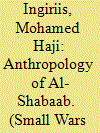

|
|
|
|
|
| Summary/Abstract |
Harakaat Al-Shabaab Al-Mujaahiduun (henceforth Al-Shabaab) is an active insurgent group in southern Somalia battling against the foreign forces and foreign-backed Somali forces. Despite recruiting both in Somalia and in the diaspora, this insurgency movement continues to increasingly recruit more local Somali youth than diaspora Somalis or non-Somalis. This article suggests that Al-Shabaab solicits support from diverse youth who – due to a confluence of factors – join the insurgency movement in various ways. The article reveals how the movement’s methods are flexible insofar as it skilfully recruits both powerful clans and marginalised clans. This pattern tests the limits of the Somali federal government in Mogadishu who have yet to develop innovative approaches to challenge and contain Al-Shabaab. The government failure not only allows Al-Shabaab to successfully carry out its operations but also to sustain itself in the midst of local communities. Through interviews with former Al-Shabaab youth, the article explores youth recruiting efforts and finds that the militant movement pursues various sophisticated means to lure numerous youth into its ranks.
|
|
|
|
|
|
|
|
|
|
|
|
|
|
|
|
| 5 |
ID:
143059
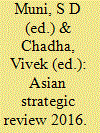

|
|
|
|
|
| Publication |
New Delhi, Pentagon Press, 2016.
|
| Description |
xiv, 380p.hbk
|
| Standard Number |
9788182748859
|
|
|
|
|
|
|
|
|
|
|
|
Copies: C:2/I:0,R:0,Q:0
Circulation
| Accession# | Call# | Current Location | Status | Policy | Location |
| 058437 | 355.005095/MUN 058437 | Main | On Shelf | General | |
| 058438 | 355.005095/MUN 058438 | Main | On Shelf | General | |
|
|
|
|
| 6 |
ID:
120668
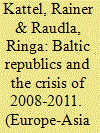

|
|
|
|
|
| Publication |
2013.
|
| Summary/Abstract |
This essay explores how the Baltic republics responded to the crisis of 2008-2011. We argue that while there are significant differences in how the Baltic economies responded to the crisis, these responses not only remain within the neo-liberal policy paradigm characteristic of the region from the early 1990s, but that the crisis radicalised Baltic economies and particularly their fiscal stance. We show that there are a number of unique features in all three Baltic republics' political economies that made such a radicalisation possible. However, these unique features make it almost impossible for the Baltic experience to be replicable anywhere else in Europe.
|
|
|
|
|
|
|
|
|
|
|
|
|
|
|
|
| 7 |
ID:
116342


|
|
|
|
|
| Publication |
2012.
|
| Summary/Abstract |
This article undertakes a descriptive analysis of the jihadist group, the Global Islamic Media Front. Using information obtained from cells broken up in the West, it argues that, in addition to its propaganda actions in support of terrorism, the group fulfils three additional functions: (a) It serves as an "identity refuge" for individuals wishing to cultivate an identity as fighters of the jihad; (b) It offers a form of "surrogate activism" to those who fail in their attempts to join organisations engaged in terrorist violence; and (c) It is an important source of violent radicalisation for its own members who become increasingly dissatisfied with their propaganda activities.
|
|
|
|
|
|
|
|
|
|
|
|
|
|
|
|
| 8 |
ID:
141895


|
|
|
|
|
| Summary/Abstract |
Somalia has become a front in the US Global War on Terror (GWoT) because of the potential connection between terrorism and state fragility. While originally oriented towards ‘building states while fighting terror’, Enduring Freedom in Somalia obtained quite the opposite result of deepening the existing conflict. Why and how did the GWoT result in the controversial outcome of ‘building terror while fighting enemies’? This article argues that the GWoT sponsored in Somalia an isolationist strategy that encouraged the political polarisation and military radicalisation of the insurgency. To explore this argument, the article first analyses the structure of the intervention by focusing on the interests and strategies of the interveners. Then it evaluates the conditions under which the modality of intervention (through the use of diplomatic, economic and coercive measures) violated the conditions essential to resolving conflict.
|
|
|
|
|
|
|
|
|
|
|
|
|
|
|
|
| 9 |
ID:
171554
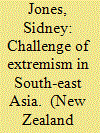

|
|
|
|
|
| Summary/Abstract |
Sidney Jones suggests that investing in research to understand extremist movements remains a top priority in meeting their on-going threat.
|
|
|
|
|
|
|
|
|
|
|
|
|
|
|
|
| 10 |
ID:
146466
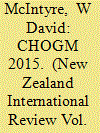

|
|
|
| 11 |
ID:
146999


|
|
|
|
|
| Summary/Abstract |
Many experts underscore a firm difference between (US) American and European approaches to combating terrorism. Other scholars contend that, since 11 September 2001, European governments have emulated the USA by “securitising” immigration and trampling on the civil and human rights of immigrants of Muslim heritage. Still other analysts discern within Europe distinct national styles of counterterrorism such as French assimilation and deportation versus British multiculturalism and conciliation. This article finds neither a coherent policy strategy nor an unmistakable political consensus in Europe regarding counterterrorism. Instead, a comparative analysis reveals a jumble of ethically inconsistent and practically contradictory measures.
|
|
|
|
|
|
|
|
|
|
|
|
|
|
|
|
| 12 |
ID:
142363
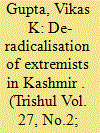

|
|
|
| 13 |
ID:
149747


|
|
|
|
|
| Summary/Abstract |
A relative oasis of stability in a troubled region, Jordan is nonetheless contending with multiple internal pressures that could yet destabilise it. Mohammed Najib surveys the security challenges facing the kingdom following the 20 September elections.
|
|
|
|
|
|
|
|
|
|
|
|
|
|
|
|
| 14 |
ID:
111539
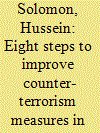

|
|
|
|
|
| Publication |
2012.
|
| Summary/Abstract |
In recent years, South Africa has come to be used by international terrorists as a safe house, for paramilitary training purposes, as a base from which to plan attacks on other countries and as a conduit for financial transactions. South Africa's own counter-terrorism initiatives have been labelled 'reactive' by analysts. Indeed, the existing counter-terrorism regime suffers from a lack of political will to issues of corruption and ineptitude bedevilling the security apparatus of the state. However, using lessons learned from other countries, Pretoria can yet turn the tide against international terrorism by adopting more pro-active measures and by undertaking steps aimed at the depoliticisation and decriminalisation of the security forces.
|
|
|
|
|
|
|
|
|
|
|
|
|
|
|
|
| 15 |
ID:
161270
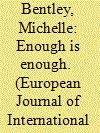

|
|
|
|
|
| Summary/Abstract |
The clash between national security and civil rights comprises one of the most controversial aspects of counter-radicalisation strategy. Analysts present this as a conflict between the need for restrictive security measures (for example, surveillance) and the need to uphold civil liberties (for example, privacy and freedom of speech). In responding to this dilemma, the article examines how this binary normative struggle impacts on the rhetorical presentation of counter-radicalisation policies – in particular, the UK Prevent Strategy and the rhetoric employed by UK Prime Minister and former Home Secretary, Theresa May. It argues that the normative environment has obliged May to construct rhetoric within the context of, what is termed here, normative invalidation. In facing two comparably compelling and related norms of action, May is necessarily required to invalidate or neutralise any norm not adhered to as an essential characteristic of rhetorical strategy. This is discussed in relation to the Strategic Narratives
|
|
|
|
|
|
|
|
|
|
|
|
|
|
|
|
| 16 |
ID:
191034


|
|
|
|
|
| Summary/Abstract |
There currently exists little evidence on the effectiveness of case-managed programs targeting radicalised individuals. This paper provides results from an evaluation of two case-managed interventions implemented by police in Australia, referred to as Intervention 1 and Intervention 2. Drawing on client case note data and interviews, the paper provides quantitative and qualitative results. It examines client change using a five-point metric and details two individual case studies. Results provide data on radicalised behaviours, intervention goals and services offered to clients. Individual client progress is explored, and the overall effectiveness of both programs examined. The results show a positive relationship between client change and different measures of engagement. Limitations of the evaluation methodology and data sources are acknowledged and addressed. Lessons are highlighted relating to the assessment of client change, program evaluation and the role of interventions in supporting disengagement.
|
|
|
|
|
|
|
|
|
|
|
|
|
|
|
|
| 17 |
ID:
148925
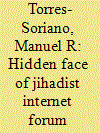

|
|
|
|
|
| Summary/Abstract |
This article offers a descriptive analysis of the private interactions which took place on the jihadist Internet forum known as Ansar Al Mujahideen between 2008 and 2010. The analysis of the non-visible part of the forum contributes to a more robust underpinning of some current assumptions regarding the jihadist Internet infrastructure and its hierarchical dependence on, and subordination to, formal terrorist organisations and charismatic leaders. In addition, it offers a new perspective on other aspects such as the many conflicts and rivalries between the different forums, the operational constraints caused by the lack of human and material resources, and the considerable vulnerability of the forums to cyber-sabotage and infiltration attempts.
|
|
|
|
|
|
|
|
|
|
|
|
|
|
|
|
| 18 |
ID:
087383


|
|
|
|
|
| Publication |
2009.
|
| Summary/Abstract |
Over the last few years, much attention has been devoted to the phenomenon of homegrown jihadist networks in the West. Most analyses have been based on the dual assumption that this phenomenon has manifested itself only extremely recently and that it is largely limited to Europe. While these two assertions are not completely unfounded, they do not take into consideration significant anecdotal evidence pointing to a long history of homegrown networks inspired by radical Islam operating within the United States. After an extensive overview of such history, the article analyzes the phenomenon of radicalization in America in comparison to Europe and the evolution of U.S. authorities' reaction to it.
|
|
|
|
|
|
|
|
|
|
|
|
|
|
|
|
| 19 |
ID:
183016


|
|
|
|
|
| Summary/Abstract |
The present article aims to further our understanding of the process whereby terrorists choose targets for attacks. It offers a case study based on information from a jihadist cell broken up by police in the province of Barcelona, Spain in April 2015 in Operation Caronte. Based on detailed analysis of conversations between cell members, obtained thanks to infiltration by an undercover police officer, it argues that the terrorist brainstorming was informed by four main factors: organizational, contextual, logistical, and geographical. The materialization of the desire to use violence in an attack plan was the dynamic outcome of the way these factors modulated the will of the terrorists.
|
|
|
|
|
|
|
|
|
|
|
|
|
|
|
|
| 20 |
ID:
092645
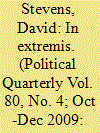

|
|
|
|
|
| Publication |
2009.
|
| Summary/Abstract |
The main policy reaction to the terrorist attacks of 7/7 and 21/7 of 2005 has been the development of the £6 million 'Preventing Violent Extremism' (PVE) initiative which aims, as part of the government's broader counter-terrorism strategy (CONTEST), to tackle support for, and the promotion of, violent Islamist ideologies within British society. One crucial component of this strategy is providing support for Muslim groups and individuals to tackle radicalisation and extremism directly at the local level. Funding and charitable status for mosques, Muslim community and youth groups and initiatives, 'forums against extremism', anti-extremism 'road shows', and the training of imams are included as part of this strategy. This article argues that this aspect of PVE is not only ill-advised, but potentially deeply counter-productive. It takes issue with two reasons that inform the PVE strategy: first, that what motivates individuals to join extremist groups are the religious ideas themselves; second, that government intervention or involvement is an effective method for rendering the moderate antidote attractive. Arguably, neither of these assumptions is warranted in the face of contrary evidence. Consequently, this arm of PVE is, at best, barking up the wrong tree; at worst, fuelling extremism.
|
|
|
|
|
|
|
|
|
|
|
|
|
|
|
|
|
|
|
|
|